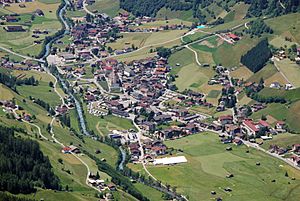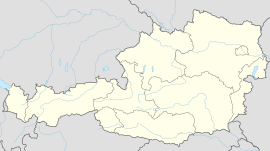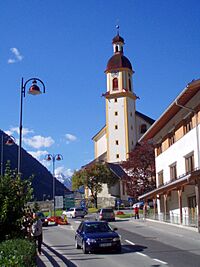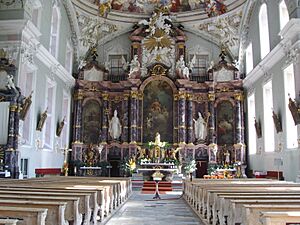Neustift im Stubaital facts for kids
Quick facts for kids
Neustift im Stubaital
|
||
|---|---|---|
 |
||
|
||
| Country | Austria | |
| State | Tyrol | |
| District | Innsbruck Land | |
| Area | ||
| • Total | 249 km2 (96 sq mi) | |
| Elevation | 994 m (3,261 ft) | |
| Time zone | UTC+1 (CET) | |
| • Summer (DST) | UTC+2 (CEST) | |
| Postal code |
6167
|
|
| Area code | 05226 | |
| Vehicle registration | IL | |
| Website | www.neustift.tirol.gv.at | |
Neustift im Stubaital is a town in the Tyrol region of Austria. It is part of the Innsbruck-Land area. This town is very large, being the third biggest in Tyrol by land area. It is also a popular place for tourists, with over a million overnight stays each year!
Contents
Geography of Neustift
Neustift is about 25 kilometers (15 miles) south of Innsbruck. It sits in a wide and beautiful area called the Stubaital or Stubai Valley. At the start of the valley, you can see huge rock formations made of limestone. Further up the valley, tall mountains made of gneiss and granite reach over 3,000 meters (about 10,000 feet). These high areas are covered in ice all year round.
Glaciers and Skiing
Five large glaciers cover about 15 square kilometers (6 square miles). They form a big ski area known as the Stubai Glacier. This valley has 42 cable cars and ski lifts across four different ski areas.
Getting Around Neustift
You can easily travel to Innsbruck from Neustift by bus. The bus line is run by Innsbrucker Verkehrsbetriebe.
Villages in Neustift
Neustift im Stubaital includes several smaller sections and villages. These are Kampl, Neder, Dorf, Scheibe, Milders, Oberberg, Stackler, Lehner, Schaller, Krössbach, Neugasteig, Gasteig, Volderau, Ranalt, and Mutterberg.
Neighboring Towns
Neustift shares borders with several other towns. These include Brenner, Fulpmes, Grinzens, Gschnitz, Längenfeld, Mühlbachl, Ratschings, Sankt Sigmund im Sellrain, Sellrain, Sölden, Telfes im Stubai, and Trins.
History of Neustift
The Stubai Valley was first mentioned in writing around the year 1000. It was called Stupeia back then. By the year 1400, the Stubai area was made up of five small communities. These were Telfes, Schönberg, Mieders, Fulpmes, and "im Tal" (meaning "in the valley").
How Neustift Got Its Name
The name Neustift appeared in records from the 14th century. It was written as "Niwenstift im tal ze Stubai." However, it took many centuries for "Neustift" to become the main name for the community. Before that, it was often called "im Tal." Even today, people from Neustift are sometimes called Tholer, which means "valley dwellers."
Ancient Settlements
Some place names in the region show that people lived here even before the Romans arrived. Around 15 BCE, the Roman leader Caesar Augustus and his armies moved north. They took control of the mountain people and their land, making it part of the Roman province of Raetia. The Romans then influenced the area with their way of governing and later by bringing Christianity.
Old items found from the early Bronze Age (around 1800–1000 BCE) prove that people lived in the valley a very long time ago. Many place names are from the Rhaeto-Romance language. This suggests that the German language did not become common in the area until the Middle Ages. Some of these old place names include:
- Falbeson: This means "pocket valley."
- Ranalt: This means "high landslide."
- Pfurtschell: This means "notch or gap."
- Tschangelair: This means "enclosure."
- Kartnall: This means "small courtyard."
- Kampl: This means "field."
Neustift's Coat-of-Arms
The town's special emblem is a red shield with a white band across the middle, just like the Austrian flag. It also has a crossbow with two black arrows crossing each other. The crossbow reminds people of the hunting trips that Emperor Maximilian used to take in the Oberbergtal area.
Population Growth
| Historical population | ||
|---|---|---|
| Year | Pop. | ±% |
| 1869 | 1,241 | — |
| 1880 | 1,265 | +1.9% |
| 1890 | 1,217 | −3.8% |
| 1900 | 1,344 | +10.4% |
| 1910 | 1,372 | +2.1% |
| 1923 | 1,372 | +0.0% |
| 1934 | 1,646 | +20.0% |
| 1939 | 1,805 | +9.7% |
| 1951 | 2,018 | +11.8% |
| 1961 | 2,195 | +8.8% |
| 1971 | 2,794 | +27.3% |
| 1981 | 3,307 | +18.4% |
| 1991 | 3,791 | +14.6% |
| 2001 | 4,328 | +14.2% |
| 2011 | 4,510 | +4.2% |
Interesting Sights
St. George Church
Emperor Maximilian I enjoyed hunting animals like deer, chamois, and boar in the upper Stubaital. In 1505, he helped start a chapel in Neustift. However, the village did not get its own priest until 1868.
In 1516, the first church in Neustift was dedicated to Saint George by the bishop of Brixen. This church was later destroyed by a fire in 1772. A new church had already started being built in 1768 because the first one was too small.
Pastor Franz de Paula Penz was the person who built the impressive Neustift parish church. He was one of the most famous architects of the late baroque style in Tyrol. In 1812, Neustift became its own independent parish.
From the outside, St. George's Church in the village center looks quite simple. But the inside is very rich and beautiful. It is decorated with colorful paintings by well-known artists. This parish church is the second-largest village church in all of Tyrol. A famous "glacier pastor" and co-founder of the Alpine Club, Franz Senn, is buried in the church's pretty cemetery.
See also
 In Spanish: Neustift im Stubaital para niños
In Spanish: Neustift im Stubaital para niños





